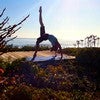Description
About This Video
Transcript
Read Full Transcript
I'm Ken Gilbert. I'm here at Plata is anytime presenting a mat class with participants. And so we're going to play with, we were, we were joking just a few minutes ago about intervertebral articulation with club vicular leveling. So the session today is about five joint actions of the spine and how do we forward flex, how do we extend, how do we lateral flex, how do we rotate and how do we circum Dr Circumlocution? So we'll play with those different joint actions. So as we go through class, we'll be highlighting that in the spine and how also how do the appendages support and stabilize how dependent appendages express and move the energy from the body, from the core into the body, from the body core out or in.
We'll play with that. So let's begin standing with your feet. Ankle bones, touching base of the big toe base, a little toe, middle of the heel, three points of contact with the floor. Then on the inner thighs right above the knee, pull in and then lower belly pubis to naval. Pull that in. We begin wrapping the base of the abdominals. All four abdominals transecting there near the pubis, the trans versus the obliques, interior exterior, and the rectus abdominis. So standing there, putting the pelvis over the feet and legs. So standing there and then zipping up the front from the pubis to the naval.
Pull in and up, wrapping the tree. Nice. Wrapping the Trans versus a little bit more like that internal girdle, the muscle that touches the internal organs. And then we're zipping up the front of the rectus abdominis to the bottom of the sternum are what I'm calling the central core of the high point. And then expand the ribcage by opening up the shoulder blades. Let the arms drift in front of the spine, fingertips in elbows out.
So there's a sense of roundness in the appendage of the arms. Then lift the sternum wide in the back. So the sensation is putting the, the bottom of the rib cage onto the diaphragm. So you lift and rest at the same time. So the body is expanded front and back, and then the maneuver, him and Chin are in relationship. So play with that relationship as we move rather than letting the chin come forward rather than letting the chin come forward to the maneuver him or behind the maneuver. IOM. Keep that sense of balance there. What am I dis unfavorite cues is to bring the chin to the chest if that's what we do all the time.
I'd like to think of it as the relationship of the Chin to the maneuver IOM and then the manubrium to the crown of the head. So we have that happening here. They have been as free to move. Yeah. So let's begin with a few PA's. I do use the per Cathy breathing, dropping sits bone straight down to the heels. So let this be a hip flection. So we have an upright spine. This is a nice cue that I just recently found. If we cut the hands here at the, at the top of the hip joint, that's the sense of a, the cuff of a ball and socket. So we played with the ass. Nice.
So dropping straight down, four more and three letting us be a hip band. Keeping the lower back, lower spine extended. Last time and stay. I did this in the last session that I did with and I kind of like it. It does warm up the lower back, tip the pubis up to the ne the navel and then reach it down. So we're not lower back extension yet. Just tip it up and reach it down.
Yes, and tip it up and reach it down. So we're rolling now. The pelvis over the head of the FEMUR and down. Let's go. Former time center. Head Up, eyes up, level the head by using the eyes level of horizon two more and beautiful. And one more. Now we go into the lower back extension. Pull the pubis down towards your toes but tailbone is reaching behind you and center and
You want to reach underneath the sternum and rib cage and make it muscular in the front. So we're playing with flection and extension of the lower back, integrating into the pelvis, integrating into the rib cage and four three to come to center and then play deeper and come up. Great. Warm up for the lower back. Then turn out and parallel. Let this come from the ball in the socket. Parallel. Turn out and parallel turnout and parallel four more.
Four and stabilize the pelvis if you can keep the lower belly in and up. Nice Amy and to and this time, play a now rotate the knees out so we pulse the knees out and around. Stabilize the lower belly. Ship up the front of you for three, two. Now play a little deeper and come up for more plays.
And let's play and stay. We're going to go through an abbreviated version of what we just did in the parallel position center back center
You really get that sense of the pelvis hanging, hanging from the bottom of the sternum, bottom of the rib cage, four, three, two and zip up the front please and come up. Let's return to parallel ankle bones above the knee. High side, zip up the front pubis to enable naval to the bottom of the sternum, bottom of the sternum to the top of the sternum, the new BREEAM and lift to let the ribcage hang. Reach the arms up in front of the face, head, neck, shoulders, and arms. Rounding over. That's the cervical browning over thoracic arms level to the floor.
Let the lower back stay lifted. Now round over even more and rather than move the pelvis, allow yourself to tip just the spine. Now tip the peep of silver rounding over all the way crown of the head to the toes or belly pulls in and up. Let's do a washer woman here. Inhale, pull up, exhale and pull down. Check in with your kneecaps to be sure they're tracking straight forward and four more and let the arms be alongside the face. Two and one now rolling up sacrament place over the pelvis or in the pelvis. Then lumbar over the sacrum and then thoracic over the Lumbar, the neck and the head intervertebral articulation forward flection.
All those words for just doing this and head, neck, shoulders and arms routing over widen the shoulder blades here, which is overweight. Tips of the shoulder blades forward riding over now into thoracic. Then into the lumbar pelvis doesn't move. You can see that the pelvis and pupil sustain right in place. Now tip the people silver rounding over all the way and then rolling up.
Check in with the kneecaps, sacral in place, pelvis and then Lumbar, lower back, and then thoracic rib cage. Let the rib cage hang them, the neck and the head. Nicely done. I want to go down to get the strap, so let's go head, neck, shoulders and arms. Rounding over and then thoracic ribcage running over. Stay there for a moment. Let's all pull back into the lower belly. Expand the reach shoulder blades.
Forward that reach towards your fingertips with the outer tips of the shoulder blades. Now expand into the lumbar. Lower back without tipping the pubis at all. You have to use your lower belly. Stabilize the pelvis where it belongs. Now, tip over and round over all the way. Take hold in the middle of your strap. Just hang on to it. We're going to do something with it in a moment. And roll up sacrum in place. Pelvis and Lumbar, lower back, lower belly. Then thoracic rib cage. Send the neck and the head. Let's start with two. Two.
So starting from the inside mark of this label, go to the two. Two. I like to play with web spaces. That comes from some of my Nia experience. Getting the tissue to expand and bite that to happen. Rotate the elbows forward or out and the shoulder blade stay wide. So now we're going to pulse.
So let's turn out now to stabilize that with a turnip, but I like to see, I'll share with you here. When we pulse out, we can use the last rather than the neck and head. So instead of being up here, we want to be more down into the back. That's coming oppositional from here. So we're really getting into an extension of the lower back here rather than a compression. So play with that. Let's do that again one more time. We're now that we're in turn, it's gonna feel a little different in the pelvis and four, three overhead. And this is about widening the back for three, simulating the latches and the store side for four, four, four and two and
By doing this we can get into the back and get more extension. So even standing up we can get more extension if we opened the shoulderblades here and play with it that way. So while we're here, let's just go into some rotation cause you're all set up nicely for that. So let's all come to the front. So y'all all into the front, rotate toward the front and then come to center and rotate to the other way and come to center. And let's do that again. Rotate. Now bring it from the bottom of the sternum. Stabilize your lower belly pubis to naval naval, to the bottom of the sternum.
Stabilize that. Yes. Then the rotation happens in the thoracic. Lower belly pulls in and up. So nothing happening in the pelvis here. It's all stable. Below the rib cage. Think of the rib cage. The diaphragm is a disc and you're rotating that disc. Let's do it one more time. Each way.
So spinal rotation of the thoracic and we can play. Then uh, we can play them with the, the head neck. So can we turn the neck and then center? Turn the neck rather than the turn the head. Rotate the neck and then center. Rotate the neck and center and rotate the neck and center.
One more time. Neck and central. Look up here for a second. What I'd like to do is this, keep the chin level to the floor and pulse teaching this apparatus, the sternocleidomastoid and the scalings how to, to stabilize and open. So everybody turned to the front.
Keep Your Chin level to the floor and turn the other way. It's cervical spine. Keep widening soul blades, elbows up and out. Four, three, two. And bring your arms up overhead as you come center with your head. So a little bit of clubbing or leveling starts to happen there. Yeah, wide back. And now let's go to the turn the head to the front and center and the other way and center. And now this is different than cervical rotation is. This is just the head four more and three and two.
Stabilizing and upright spine one and single breath.
Yeah. Rotation. Little dizzy though. Yeah. Okay. That's also good for vestibular, vestibular, eye health and healing here. So let's play. Then with the lateral will go sideways. Let's go forward first, front wall, first and side, bending side, bending pelvis, chest head. Keep the head in the frame of the arms. Then return pelvis, chest head. Now imagine you have a cylinder or a ball, so you're moving up to go over play with that the other way, up to go over lateral flection.
Then play with the opposing side and we're playing with them. That lateral extension as you come up, that was nice and lateral flection, side bending and then coming up. Lateral extension head behind the arms, the head falls forward. You start to compress the neck and shoulders. You don't need to do it that way. One play with opening the space, pelvis, chest, head.
Let's do this two more times. Each side. Remember the thumbs to be pointed at a wall behind you and then pelvis, chest, head and pelvis, chest, head side, bending, lateral flection and coming up. Pelvis, chest head one more time, each side, pelvis, chest, head, getting as much length as you can. On the one side, no compression on the other side. Do you want to think of extending both sides really and lifting up out and then coming to center and arms down. I want to add to something here. We're going to play with this. The pelvis moves side to side, so clavicular leveling doesn't change, so let's play with that. Take your hip to the side, thumbs forward, open the hands and Paul's and then open also the elbows and we go side side. So we go side center. Side Center. Yeah. And
I wish everybody could see this from the front. This is very cute. And four, three, two and one. And let's make it a single breath. Pelvis, pelvis. Now imagine you have a string from hip joint to hip joint and you're running your pelvis along that string. Four three. This is too cute. Two and one. Now pulses four, three, two and bring the arms up overhead. So now we're going to play with it.
This way we'll sideband and then we're going to take that pelvis to the side. So it's a hip stretch side, bend to the front, first side bend, exhale. Then hip stretch, reach with the hip. We just establish that and then come back. Pelvis, chest head. So it's a little more extreme. Lateral flection side, Ben first. Now we invite the Lumbar to participate by getting that hip stretch and to that.
Yes. And then coming up, all of you hold the frame or specifically clip. Vicular leveling will hold that stability of the shoulders wide. The head stays in the center of the frame. Yep. Side Bend, first
The extensions that are happening to return. Yeah, so play with that more introvert, Cibele articulation side. Ben, first
Pelvis, chest and head. Last one. Sideband hip stretch and return pelvis. Chest and had gotten lower your arms. So this becomes really a point of pivot and point of connection for all of the work. So we're here. Let's do, I've got to add in before reflection to the side bend, hip stretch. There will be this here to this. So play with that connection of the forward flection.
We'll return to the side bend here. Stabilize as best you can. The frame around the head and arms. Yeah. Here we are, side bend, hip stretch and Ben. Forward flection, side bend, hip stretch and forward flection. Side Bend, hip stretch and for reflection one more time on this side, side bend, hip, stretch and forward flection, side bend, hip stretch and then return to the extension here, upright and the other side, side bend, hip stretch and for reflection
So if you notice what actually getting into this part of the circumduction just part of it. So we're here. Oh, I love that. I love that. Yeah. Okay. We could actually use that as traction to get to the crown of the head. So I guess we're going to do that. Yeah. Yeah. So you pulled out and now reach the crown of your head to the ceiling.
See if they can stabilize your chin. Yeah, this is good. I love this when it happens. Thank you Hailey. This is very good. Yeah. Do you feel you're decompressing a little bit in the neck? Yeah. So reach the crown of the head, Richard. Reach it, reach it, drop your Chin a little bit less likely. Please. I stay forward. Yeah. Yeah. Good. And then let's release that. Wonderful.
So that brought up the other thing that we'll do, and that will be the Moose. So we're here, we're going to do a head check now. Get that same sensation. So we're getting an extension in cervical spine. Elbows go out to the side and the strap goes to the crown of the head. Bring the elbows forward. Yes, that's it.
And then coming up and then elbow pull [inaudible] crown of the head with a strap. Yep. So don't we look like a bunch of Moof? See like a that? Yeah. Yes. So the Moose poll form [inaudible] and three, actually it's part of the framing for ballroom dancing is to get the, the arms to reach out this much and keep the back wide last time and then come on down with your arm. All right, so we've done forward flection, we've done some rotation, we've done some, uh, a little bit of circumduction. Let's play with the extension. So let's play with it this way. Pull your lower belly in and then imagine you have a cylinder or a ball at the bottom of your stern or the bottom of your rib cage here opposing to your sternum and you're going to be lifting up and over.
So I want to see that extension. This is the rassic primarily a little bit of cervical pay attention to this. So if you keep checking in with this rather than let your head fall back, your extension, we'll go further. You keep checking in and keep regulating that relationship. Yeah. So regulating this relationship, I don't want to do that cause that's something else I want to go over here.
Regulate over here, regulate over here, regulate. You can hear the change in my voice when I get to tense. Right there is what I would prefer. Then I can go even further. Yeah, so we're really reaching out out of the bottom of the, of the rib cage. Yeah, top of the lumbar. So here we go. I'm going to watch just so I can see what's happening. Pull the lower belly and zip it up.
Pelvis is stable so we're not moving from the lumbar at all. We're letting it be protected. Wrap the trans versus deep into the belly. Up and over, up and over from the [inaudible] out of the rib cage. Keep changing your focus with you. You're taking your focus. You're not looking up or down. You're looking out, looking out of the top of the spine, looking out lower belly pulls in and up top of the spine.
Now coming up right with them. Do that by going into forward flection and then come up and go over four counts for lower belly, zip it up, protecting your lower back by wrapping the transversus at the bottom of the sternum. Yes, the transverse and yet this is the gorgeous wrapping at the bottom it. Yes, you're all getting this coming up right upright and bend forward flection to unwind any tension that was built up in the neck and shoulders. Let's do this two more times coming up and we're going for a full spine extension over four counts for lower belly zips up, self correcting the neck and head suitable three, keeping your focus out of the spine, out of the spine and yes, and then coming up and rounding over for reflection and then one more time coming up and let's do the extension over four and three the lower belly zips up rapid trans versus the rim of the rib cage. The diaphragm is engaging here. Last one, Chin maneuver. IOM and then coming up and over.
There's so many things that I get inspired to do when I start seeing bodies move, coming up and then arms down. Take a break on that. That's extreme. And when you find the power of opposing to that, then everything is protected. If you don't, then things are compromised. So be careful when you do that. Learning how to be here. Being in the introvert that I am, it's just one of those funny things where I had to learn to look out into the world instead of looking. Uh, not. Yeah. So let's go here. What a play with it this way.
So you're going to go into a fluxion first and then you're going to go into an extension here, tailbone out, and then come back into the flection here and then come up. That's the pattern. Yeah. So forward flection first into the extension. Reach the sternum up toward the crown of the head, and then round back into the contraction for reflection and then come up. Let's do this three more times, then forward flection of the thoracic, then extension into the lumbar. Thoracic. Nice. Amy. Good George and then rounding over, pulling back into the, I do this on the petty pole is a great move to round it because you get the feedback in the lower back.
Nice Karen and forward flection to the extension and then forward flection and then the extension to uprise one more time. Then we'll reverse it. I love the growth of this. That's the intervertebral articulation and feel the space between the Vertebra activating the muscularity of the spine. We have at least four layers of erectors and we start to work that way. So hinge forward first, find your balance and then round back into the flexin and then extend out into the hinge or the extension and then come up.
Let's do that three more times for reflection at the hips and then forward flexion of the spine, hips and then come up tomorrow and full reflection at the s the hips forward flexion of the spine for reflection of the hips and coming up last time and for reflection of this spine, pulling your lower back over your sacrum and then extend and then come up on sound. Good. That's all. Well, we haven't done it yet. Let's do it. Let's do the second eduction. Y'All all working. You're doing beautifully with your articulation, intervertebral Lee introvert. Timberly. Yes. Yeah. And your curricular leveling is stunning. They don't get to see it as much as I do. And here we are.
Let's play with then the circumduction. So you might want to stag yourselves around a little bit just to play with this. So what we're looking for is we'll start with forward flection of do this again in the spine corrector session here and we go into the side lateral, then we go into the extension pulling on that lower belly, really fight for that and then lateral and then around. Yeah, we'll do it four times each direction. So you get a sense of that. Remember, hang on here is protecting your lower back. Otherwise you're just exposing it. It's not that that could be something interest, it's just that it's something you want to avoid. Any stress, the lower back. So we're here for reflection. Let's all go to the front wall.
First and lateral, Ben extension and lateral and around. So the lateral is the inhale and then shh and lateral and flection to more lateral and extension, lateral and flection, last time, lateral and flection, ascension, lateral and flection the other way please. And she now find that point. It's the bottom of your stern in the bottom of your ribcage behind you and you're playing with that connection of that point, that center core, the high point. And that's your pivot point for the circumduction last one. And then coming up and Armstrong. Yeah, so we've done all five joint actions of the spine while standing.
So let's go ahead to the floor, to the mat. We'll go down this way. Head, neck, shoulders and arms rounding over and then thoracic ribcage running over. Zip Up the front of you, round over. [inaudible] more stretching into the lumbar we've worked at. And then tip the pubis over all the way.
Routing over fingertips go to the floor, Relevate or heels high around the crown of the head, towards the toes. Bring your inner thighs together. That tailbone is reaching towards your heels, the crown of the head to the toes, forming this ball pulse, the knee bend. Letting hips get heavy crown of the head. Get heavy. Sure. Four, three, two. Come on down to your knees and then go onto your hips. You go into, onto the mat.
We're going to go into diamond or play with with that way, have your strap nearby. In case we decide to use it. I don't know what we'll do. I'm going to go the other way. So now we're seated. Seated into intervertebral articulation of stability. So lift, take hole below your, your knees, lift your sternum, widen your back. There's another opportunity for you to level your clavicle to get that, that bone to be across the chest and to stabilize the shoulder. Girl lifting up. Get the heels a little further away so you have more stability. As you go back, you're going to pull the pubis to the navel.
What we did at the very beginning of the warmup, so there's no backward movement yet.
Then pull the tips of your shoulder blades forward as you roll up into that sit. So you can do it without the head falling forward. So what I'd like to see is that you're maintaining, sustaining this because it opens up the back of the neck differently and then coming up that same way. Yeah, so let's play with that detail two more times. Fitting up diamond dropped the pubis and then roll back puberty. It's enabled. And then onto the back of the sacred back of the pelvis.
Been Rolling on down to the lowest rib. Tips of the shoulder blades. Open the elbows out cause it does level the clavicle. Different fingertips are facing inward. Then rolling up lower belly in and up, keeping the head floating eyes level to the floor. You stabilize differently that way. One more time and lengthen up. And then cubist, enable and roll back to the sacred elbows up.
Open out and lowest rib tips of the shoulder blades. Then rolling up lower belly pulls in and up. And I see what we're going to do next. If your strap at two to throw it on play with. Now as we are going to play with how the cervical spine goes into relationship with the thoracic, so we're here, you'll go back to the sacred first.
We're all inflection here. Then the tips of the shoulder blades, wait for the arms and then go on back. The arms come up and then a roll up into the thoracic flection and then roll up pulling the shoulder blades forward. That does a lot of work here. Opposing here. Yeah, so beautifully demonstrated by the almost 63 year old man. 63 this month. So here we go. Lengthen up and pubis to naval rollback. Yep. The sacrum, the back of the pelvis. Press your feet together. Open your knees wider.
Lowest rib pressure, feet together. Opening high tip of the shoulder blades. Arms come up alongside the face. Then roll back. Neck and hip. Thumbs touch. Yes. Arms come up over the shoulders. Lower belly wrap the trans versus roll the head up ended up [inaudible] even though the arms are moving. Yes. Now roll up all the way to sit or belly pulls in and up. Upright fit.
Let's do this one more time and arms reach out. If the more you do this, the more you're going to stabilize your shoulder. Lifting up first and then by belly or cubist enable and then lowest rib.
Arms come up over the shoulders and Ben Rolling up bottom of the sternum. You articulate to the thoracic pressure feet together. Open your Nice Haley. Well, yes, Karen. Thank you. Yeah, so let's play with this. Now we're going to rotate. You're the traction across your shoulder.
Blade will help you stabilize your level. Clavicle even that's challenging level clinical for clavicular leveling. One more each way. In my healing of my shoulder injury from a year and a half, a little over a year and a half ago, I learned that the decompressing of the shoulder girl decompressing by opening this joint here helps. Then overhead and
Let's play with the circum duction or circumlocution of this in an interesting way. You're going to rotate, you're going to get down on the side, come across and come up on the other side to center. Yeah, so it's not going to be a lot of movement, but it's a wonderful feeling. Going back to the bottom of the s the rib cage. No further back. Yeah, tips up the shoulder plates. All right, got it. All right, so like one up first. Now rotate to the front, roll down on that side of the spine. Come across shoulder blade to shoulder blade, then roll up on that side of the spine. Steven, do it without pulling the head forward. Keeping the shoulder blades wider and then center. Yes. Either way, rotate first roll back on that side of the spine.
Come across to the other side of the spine and then coming up, keep it head over the maneuver and rather than forward. Yeah, there's a little bit of Chin action going on. Let's fix that and rotate and roll down and come across and roll up just center and the other way rotate and then roll down. Keep your head back over the spine rather than in front of the chest. Different. That was nice change. Yeah. Nice. Cute. And one more time each way. Rotate to roll down.
So we are getting into a circumduction and come around and up on that side. Press your feet together. Open your knees wider and the other way. Last time.
So the more we have available to us in that articulation, the better off. We're going to be little philosophy there. All right, let's go here. Arms Up, over and round over. Now this is the forward flection. Now Flex your feet and as you flex your feet, you're going to grow to an extension. Ab Degree of extension is individual.
So what I want to look for is the flat back from the bottom of the sacrum all the way to the crown of the head. Now round over, point your feet and roll up pelvis, chest and head. Lower belly pulls in and up. Yeah, so keep the arms in the frame here or here. So let's go again. Arms reach up and round over crown of the head towards the toes. Now grow the extension through the crown of the head and the strap.
Flex your feet, your arms are overhead. That's going to help you find that extension arms in front of the face. Now round over, point your feets and roll up. Keep the arms out in front of the chest. A little bit of mind control there about what am I doing?
Arms up and round over forward flection. Now grow the extension, flex your feet and grow the extension. Find it in the bottom of your rib cage. Go into the Lumbar, you want to use those lower back or rectors. We'd go to sleep at the bottom of the rib cage. We go to sleep in that opening of, of the, the diaphragm and the the QL and the so as now round over, point your feet.
Keep the arms in front of the shoulders as you roll up or belly pulls in and up. Nicely done. And everybody has their own version of this depending on how flexible and open you are in your hips. So let's do it one more time. Beautifully done. And round over crown of the head to the toes, reaching, reaching, reaching out. Grow the s the hinge or the flat back. This is extension there.
Yes. And now round over again. Point your feet and then rolling up pelvis, chest and head. Nice details. Yeah. So now let's play with this a little bit. Hinge back and come up. So if that's a little scary for you cause you're not quite confident in this connection here, stay here. It's just not as oriented to a flat back from me.
I find it more challenging to where my arms in relationship to my flat back here. I got it. So let's play with that. Yeah, let's do that four times. Hinge back now. Lengthen the hinge and come up and hit your lower back's going to work and hinge back and lengthen the hinge and then come up. When I say lengthen the hinge, what I'm looking for is a little bit of that to happen and it's coming from, it's actually coming from, you're in this position, it's coming from that. So you're actually going to might feel a little hyper extended.
That's a good thing cause right, right then we're a little compromised. Yeah. Laura belly pulls in and up and hinge. Now grow the hinge, Chin and relationship with the maneuver him. Nice Leslie and come up and one more time. Hinge back, row the hinge lift you urbanize I like that. And come up and then arms down. Yeah. So let's play with the full range of motion. There'll be fun to play with.
So this is where I get spontaneous cause you're all bringing yourself and this is what's fun. So hinge bat will come up and then grow the pelvis. Chest head. Yeah. So we're creating a movement from that. So we're here, hinge back first. Now grow the hinge and then forward flexing. Oh over now reaching the hands out. Reach the hands out. We know that we've been there. Yep. And then come up and arms down. Let's play with that. Here we are and lengthen and
What matters to me is your spine right now. Yeah. Cause we can do it this way. We could do it this way and I'm not about that. When we get into this kind of, this is very intimate relationship with your spine. One more time and hinge back, row the hinge and round over and then grow the hands there. Flex your feet. That's the detail that helps your balance and been around. Oh over and roll up.
So I wonder what we want to do right now that's kind of fun. Um, lateral we have to do some lateral while receded. Yeah. Lateral. So go with three to two on one side. For those people who love to put labels in the middle, you'll just have to let it go. Cause now we're at three, two. I've actually had people do the class this way and I say no, we can't do that anymore. We're now here. So we'll do this a little bit with the spine corrector.
Lift the sternum wide in the back and let's all go to the front wall. Yep. Now stay where you feel most secure with your lower back, lower belly lift up to go over and lift up to go over and lift up to go over, keep your head in behind your arms, lift up to go over and then coming up pelvis, chest head. Be careful not to fall into it. Yeah and the other way over and you're going up to go over, you're going up to go over, you're going up to go over one more. You go up to go over and then coming up to center.
I've got your thumbs forward so that we're going over. We're going to actually be touching the floor if you're ready to, if you're not, I'm not concerned about that. It's just that that prepares it. This is a little funny feeling to me, so we're here, thumbs forward and all of you keep your head focused forward so you're not turning your head at all. What happens sometimes is we get a little confused in our neck and shoulders and I am watching your clavicular leveling, widen your back, lower belly and go up to go over, up to go over. Remember if you get to the floor, that's great. If not, that's not the objective.
The objective here is to get a sense of the side bending and then coming up, pelvis, chest, head up to go over, up to go over, up to go over, nice up to go over and then coming up. Pelvis, chest head one more time cause most of you are getting close to the floor. If not, they're up to go over, up to go over, up to go over head stays behind the arms, up to go over and stay there just for a moment, just for a moment, get as much lift out of the opposing side. So if you're going on, whatever side is bending to lift up out of that, just get a little bit more. Reach out of that and then come back to center. The arms always self adjust and then going over last time up to go over, up to go over. Nice lift up to go. I love that up to go over one more and let's just be there for a moment.
Good care new there. So play with as much. Reach up out of the side that you're bending into and then coming up center and arms down. So we have done forward flection, we have done extension, we have done a lateral, we've done rotation, we've done circumduction. I think we've done it. Yeah. So let's come up. Find your way up to upright. Lower belly pulls in and out. Let's just play with a little bit of balance and see where it can play with the spine. Uh, when I studied with Fletcher, we would do this every once in while.
It was so much fun to play with. So a slight turnout and what you do is you le you reach forward and step on it, then reach forward, then lift the leg and come back. You lift the leg, step on it with the leg and return. The objective here. Now as we've done so much articulation through the spine is to center. So it's all coming from here. My philosophy is that the legs are connected here, the arms are connected here. And when we work in our theater company, we work with the spines and how character evolves. So this kind of person is going to have a different character than this kind of person, this kind of person. So the spine does reflect character.
So I want to play with this stabilize more centering and more neutral. I don't like that word so much, but that's what it is about where my spine is in balance. And centering. So we reach forward and step on it and reach forward and return. Reach forward and step on it. Reach forward and return. So stay lifted in your spine forward and step on it forward and return forward and step on it forward and return. Let's do that four more times.
You can do it without any pitching forward or leaning state up right after work. The electrodes of the lower back. Stay upright.
Do you want to, yeah, let's do that. They all know their sides by now. Now they're gonna see your backside and side and center. So you want to not overshoot it. Probably exception. You turn it on, you come back to central, you gotta go to work then and center. And
You overshoot to come in. That's where you're going to be working a little higher into the glute. Yeah, yeah. Got It. So let's do that. Eight times,
I love that when I tell people that Joe wanted us to go to work and then return to our life, that's why he called his book got returned to your life. So now you're walk out of here with a different sense of yourself in the world. That's my philosophy about it. So I stayed with it for over 20 years and
Comments
I am pleased and excited to hear that the class supports your learning through Pilates. I love teaching this work.
You need to be a subscriber to post a comment.
Please Log In or Create an Account to start your free trial.
























